THE RIGHT CYCLING SUNGLASSES

Choosing the right pair of cycling sunglasses can be hard.
Like most cycling gear, cycling sunglasses or cycling glasses perform differently and come in a wide price range. And like a lot of cycling apparel, there are fit and fashion considerations with cycling sunglasses that can further complicate our decision of which one to buy.
Then we have different light conditions to worry about depending on when, where, or how long we ride. Plus, it sure would be great if the sunglasses that are best for our rides also look casual enough to wear when we’re not riding.
My solution has been to have that one pair of the best cycling sunglasses with multiple lenses or a photochromic one that could somewhat pass for normal sunglasses when I’m driving or at one of the kids’ games or the beach.
My reality has been that this “solution” has always been a compromise. I find myself spending too much time switching lenses before rides or not being happy with how light or dark the photochromatic ones get. And the ones that perform best for cycling look a bit out of place when I wear them in most other situations.
While I’ve always used one pair of cycling sunglasses, it dawned on me that I might want to have another pair or two for different situations. After all, I have several different weights of short-sleeve and long-sleeve jerseys, both road and gravel shoes, switch between climbing and aero wheels, and… well, let’s stop there so I don’t get in deeper water with my budget boss.
So I put this challenge to my fellow testers Nate, Miles, and Aiyana – Pick out three different pairs of sunglasses that, between them, would cover the range of situations you ride in and wear sunglasses for, be it on relaxed rides or group rides or races, on the road or off-road trails, in early morning low sun to bright midday to late afternoon/early evening light, during the spring, summer or fall, after rides or not when on rides, or whatever situations where you think a different pair of cycling glasses might be best.
With the summer ending and the fall light coming on during our testing, and as we added more MTB and cyclocross to our road and gravel riding mix, this was a good time of year to try out a lot of sunglasses in a range of situations.
Below you’ll find what we experienced riding with those each of us selected. Hopefully, you can find situations that relate to your riding and see if what we found in our reviews helps you pick out your next pair or pairs of cycling glasses.
In The Know Cycling is ad-free, subscription-free, and reader-supported. If you want to help keep it rolling without any added cost to you, buy your gear and kit after clicking the product name links in this review. When you do, we may earn an affiliate commission that will help me cover the expenses to create and publish our independent, comprehensive, and comparative reviews. Thank you, Steve. Learn more.
Nate’s cycling sunglasses selections
As my longest-serving fellow tester (i.e., he’s put up with my requests for product feedback more than anyone should have to), Nate has evaluated a lot of different cycling gear and kit over the years. And as a guy who leads his club’s 23-25mph group rides, spends time riding in a lot of different road and off-road conditions, and has built a career in the world of optical device technology, it’s fair to say he’s one whose perspective on cycling sunglasses I want to know.
Here’s what he thought of the ones he chose to test.
Tifosi Optics Crit
Available starting at US$50/£48/€58 using these links to BTD (BikeTiresDirect), Performance Bicycle, Amazon, and Merlin.
The Tifosi Optics Crit Photochromic cycling sunglasses I tested (they also come in a polarized version and one with interchangeable standard lenses) are my favorite for road biking on dark mornings or in limited sunlight. They don’t have the annoying lens flares you can get when headlights are facing you, like the Julbo lenses I write about below.
The Tifosi Crits feel light as a feather, are very secure, and are unobtrusive in my peripheral vision. Because they aren’t as big as many of the cycling glasses you see today, they have a bit less wind coverage but are still adequate on road rides as your eyes aren’t constantly working to see roots and rocks at hyperspeed the way they would riding off-road.
I experienced no issues with fogging. The lens has no color tint, and I like that it is completely transparent in dark conditions. However, I would prefer to have the photochromic adjustment go darker in bright conditions.
The Crit lens is relatively easy to clean with a minimal plastic frame. It also comes with a nice hard case plus a bag that doubles as a lens-cleaning wipe.
All of this, for just $80 at the regular price, makes it an easy choice for early morning training rides.
Julbo Rush Reactiv Performance Photochromic
Available starting at US$230 using this link to Competitive Cyclist and BikeInn.
I do most of my mountain biking in the fall when the mornings can be dark, under sometimes doomy skies with mottled sunlight at best. My vision can suffer as the cold wind causes constant eye tearing.
In these conditions, I really like what the Julbo Rush Reactive Performance Photochromic sunglasses do for me. Their lens provides very good coverage to block the wind, and I appreciate the improved safety and confidence of being able to see better. Despite the frames hugging my face, the sunglasses still ventilate well, and I don’t have any fogging issues.
Overall, they are quite comfortable. They stay secure on my head and face, are reasonably lightweight, and give you the feeling of high-quality construction and materials.
The orange lens on the pair I tested has a slight blue tint. The metallic lens coating also creates some flares in high-contrast situations like car headlights (more motivation to get off-road). I would also prefer the photochromic adjustment to get darker in bright conditions and more transparent in lighter ones.
You can get prescription lenses for these and other Julbo frames.
On the hygiene front, the amount of plastic in the frame makes cleaning the lens a bit more difficult without a Q-tip. These Julbo do come with a soft storage case that doubles as a lens cleaning wipe, but it’s too small to easily insert glasses into.
Smith Deckboss Polarized
Available starting at US$82 using these links to Competitive Cyclist and Amazon.
I selected the Smith Deckboss Polarized sunglasses for bright, dry days when fogging and rain aren’t a concern. I also wanted their polarized lenses to cut down on glare and the option to get prescription lenses so I don’t have to bother wearing contacts. Finally, I wanted a pair that would look more stylish in non-athletic settings.
These do all of those things but are not ideal for me.
These were my least favorite as far as my regular morning riding goes, but I think I would gravitate to them during times of the year when the sun is already up at the start of the ride and is high in the sky by the end of a ride. The two photochromics I wrote about above don’t get opaque enough in bright conditions the way polarized lenses do, and there is no substitute for polarized lenses when there is a bright glare coming off wet roads.
These Smith lenses are high-quality and have good clarity. But overall, the frames feel less secure on my head and face and could benefit from some more adjustability. The nose grips are static and a bit too wide for me, while the arms depend on resting on top of my ears rather than squeezing sideways into my head to hold them in place. They also feel a bit on the heavier side.
All of this together causes them to side down slightly when I tilt my head. And while they have a more casual look than most of today’s cycling sunglasses, they still have a rather large “Google-like” appearance, at least on my face.
I think they would fit and look better on someone with a wider face and a more pronounced nose bridge.
KOO Spectro
Available for US$190/€140 using these links to Competitive Cyclist, BTD (BikeTiresDirect), Amazon, and BikeInn.
Can a pair of cycling glasses be uniquely stylish and ultimately practical at the same time? That may be what KOO had in mind with their Spectro cycling sunglasses. Or perhaps Steve was telling me to raise my fashion game to the same level as my performance when he passed these very different-looking, photochromic lens cycling sunglasses to me to test.
The KOO Spectro does have a ton of frontal coverage, a very popular style in cycling sunglasses these days. And yet, all that coverage doesn’t interfere with my regular Evade aero road helmet which comes down my forehead brow lower than most helmets I’ve tested.
Scoring another point for the practical side, the Spectro doesn’t feel heavy despite its large lens, the frame surrounding it, and rather chunky-looking temple pieces connecting to relatively thick arms.
The Spectro’s nose pads and the offset of the lens from the frame keep the lens well off the skin of my face. I don’t get any oily smudges on the lens from my eyebrows like I often do with more compact cycling sunglasses. This design also makes them very well-ventilated.
Wiping the large Spectro lens clean is yet another way in which style and functionality seem to work together with these sunglasses. Unlike popular max coverage models from Julbos and Oakley, this KOO’s frame doesn’t overlap the lens at the nose arch. That makes it much easier to wipe the inside surface of the Spectro’s mono lens or the two separate lenses in more traditionally styled cycling glasses.
The KOO Spectro also passes one other important test for me. It remains very secure when I shake my head despite the earpieces not having any adjustability designed into them to change the comfortable amount of pressure applied to my temples.
On the downside, the Spectro’s lens coating reacts with or absorbs water, leaving a subtle yet noticeable distortion when looking through it, even after the water has been wiped off. The distortion eventually goes away after the moisture has had more time to evaporate.
While I first observed this on a rainy ride, I tested it again at home and verified that it is a repeatable condition. Is this a side-effect of the coating on photochromic lenses in general? While I haven’t researched this or experienced it with the photochromic lenses I’ve worn in the past, I tested the Julbos photochromic lens I also reviewed for this post in the same way but didn’t experience any distortion.
Because I ride in varying light conditions, I like the Spectro’s 13% to 69% visible light transmission rating and am a fan of photochromic lenses in general. Unfortunately, I’m not a fan of this lens’s pink or rose color. KOO also makes these glasses in a range of standard to stand-out lens and frame color combinations that let in between 11% and 23% of the transmitted light.
The sharp angles of the lower half of the frame and large temple pieces give the KOO Spectro a truly distinct look. It may appear quite stylish to some; for me, not so much.
Find what you're looking for at In The Know Cycling's Know's Shop
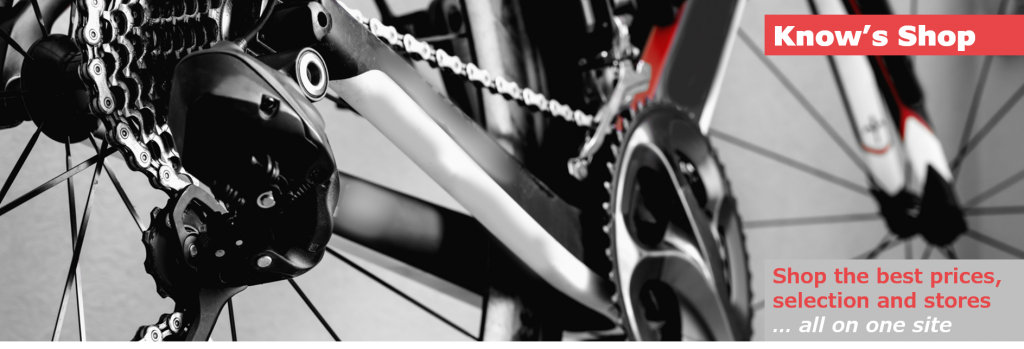
- Compare prices on in-stock cycling gear at 15 of my top-ranked stores
- Choose from over 75,000 bikes, wheels, components, clothing, electronics, and other kit
- Save money and time while supporting the site when you buy at a store after clicking on a link
Aiyana’s cycling sunglasses choices
When I open up my Strava, one of the first things I look for is Aiyana’s rides. She never seems to do the same ride twice, includes great photos with most activity reports, and gets more kudos and comments than anyone I follow.
With her review of the best women’s bibs shorts, she proved to me and a lot of readers that she can also evaluate cycling kit. Here are her reviews of three cycling sunglasses to suit her wide range of riding.
Julbo Fury Spectron 3
Available starting at US$140/€90 using these links to Competitive Cyclist, Amazon, and BikeInn.
These Julbo Fury Spectron 3 cycling sunglasses have a larger coverage area than what I typically wear. I really appreciate the span above my eyebrows so the sun doesn’t sneak in above my eyes. They also give me a wide/panorama-type view without the frame getting in my line of sight. Yet, they are very light sunglasses.
I’ve ridden with sunglasses designed to block a lot of light that can become too dark in the shade. This can be problematic when riding through tree-shaded narrow roads in my area, especially in the late summer and early fall when the sun is low. In these conditions, however, I love how clear and defined Fury’s lens makes the sometimes uneven road surface look. And, the Spectron is the non-photochromic version of the Fury, yet it still performed very well in the shifting light.
On occasion, my eyes water quite a bit in cool temperatures, especially on descents. That is not the case with the Furys. My eyes feel very protected from the elements.
The lens on these sunglasses doesn’t fog up even during stops on rides that start relatively cool and warm up. That’s quite impressive, given how close they sit to the face.
Rather than two touch points – nose & ears – I have four with the Fury – nose, ears, eyebrows & (somewhat) cheeks. This fit was a little distracting on my first ride, but I soon forgot about it & enjoyed the views. On subsequent rides, I’ve gotten more used to the fit, and the overall coverage and lack of fogging are excellent. To make them perfect, I’d add a nose piece so you can choose how they rest on your face.
Oakley Evzero Blades
Available starting at US$177/£120/€175 using these links to BTD (BikeTiresDirect), Performance Bike, Amazon, and Sigma Sports.
The Oakley Evzero Blades come in various colors (more than shown above), each with a slightly different transmission and protection index rate. I chose the Polarized Road cycling glasses for Medium Light conditions that I thought would be perfect for a cloudy or mostly cloudy day and/or sunrise.
My first observation was that they were slightly darker than I might have typically worn on a cloudy day. But as I continued my ride, I noticed the high contrast they offered more than made up for the slightly darker shade. The New England Fall leaves were also much more vibrant when looking at them through the Evzero Blades lens than with my naked eye.
Wearing them after a storm, I felt I could better navigate fallen debris looking through the lens on these cycling sunglasses than with my naked eyes. The Blades performed even better as the sun came out slightly towards the end of the ride. The high contrast seems to allow for any shade/light conditions to have a very minimal impact on my ride visibility.
These glasses are very light and comfortable to wear and fit my face perfectly despite being advertised as “men’s” like all the others. The only change I might make would be to increase the height of the frame so that if the sun were further overhead, it wouldn’t shine into your eyes over top.
After wearing these Oakley Evzero Blades, I find them to be an excellent pair of shades to wear on a partly sunny and/or sunrise ride. Under full clouds, I may opt for the Smith Ruckus reviewed below or perhaps a pair of Oakleys with higher light transmission.
Smith Ruckus
Available starting at US$215 using these links to Competitive Cyclists, BTD (BikeTiresDirect), and Amazon.
The Smith Ruckus cycling sunglasses come in a range of ChromaPop versions, and the Photochromic one I selected also includes a rose flash ChromaPop lens.
Like the Jublos, I really like the coverage of these glasses. They sit very comfortably on my face, and nothing blocks the view.
The nose strap is adjustable, allowing me to modify how close the glasses sit on my face. I like the bridge that the frame created above my eyebrows as well.
These cycling glasses work very well during rides that start in complete darkness, sometimes below freezing, followed by clouds, shade, and sun. They don’t fog while riding through these temperature and light changes, even with my face covered on the coldest mornings, and only fogged up a little during quick breaks.
The additional ChromaPop Rose Flash lens easily interchanges with the photochromic clear lens. It does its job of contrasting colors very well. I rode with it on a cold day with clear, sunny skies on trails covered with freshly fallen leaves. Some trails were narrow with little wear, so noticing the difference between trail and off-trail was pretty challenging. I didn’t miss the photochromic aspect, even in the shifting light between the trees. It’s a nice “bonus” lens for brighter trail conditions or a cloudier road ride.
Steve’s cycling glasses picks
As I mentioned in the opening, I’ve always been a one pair of sunglasses kind of cyclist, switching back and forth between clear, amber, and darker lenses.
I’ve also tried a photochromic lens to save myself the lens changing (and smudging and then cleaning) hassle but I found they also got darker than I’d prefer. This can make it seem like the day isn’t as nice as it looks without my sunglasses on. With photochromic lenses, I also miss some of the contrast and pop I get from color lenses both on and off-road.
So began my search for the right pair of cycling sunglasses for each riding situation. Here’s what I’ve found so far.
Oakley Sutro Lite
Available starting at US$184/£104/€127 using these links to Competitive Cyclist, BTD (BikeTiresDirect), Performance Bike, Merlin, Sigma Sports, Amazon, and BikeInn.
I wanted to check out these Oakley Sutro Lite cycling sunglasses for my everyday road riding on clear, sunny days. And I won’t lie, they also looked way cool, or, as Miles says: “all the kids are wearing them.” Yeah, count me in!
This was my first go with a pair of max-coverage sunglasses, and it was surprisingly successful. The Sutros feel as light and comfortable as smaller ones and have good airflow on hot rides. The Prizm Road lens on the pair I wore (they also come in a darker Prizm Black and Prizm Road Black) is wonderfully clear, easily brings out road imperfections while also blocking the direct sun without glare, and the colors seem true.
The thin frame stays clear of my low-brow aero road helmet across the front and along the sides. When I take them off for a café stop or during a ride, they also fit securely in my Kask helmet’s vents.
They do look big from the outside, but they don’t feel that way looking out of them. And when I look down, light does come in. That’s the tradeoff of not having a frame that touches or comes near my face along the bottom of the sunglasses. They almost make me look like a fast cyclist until I start riding. Who knew that was possible?
My only complaint is that since the frame comes up just above my eyebrows, I must remember to wipe my forehead from the middle out rather than bottom up. That and the fact that they aren’t cheap, though there are more expensive ones out there that I’m not sure are much better.
Tifosi Optics Sledge
Available starting at US$80/£48/€58 using these links to BTD (BikeTiresDirect), Performance Bike, Amazon, Merlin, and BikeInn.
Gravel riding in New England almost always means lower light conditions because a lot of it happens in the woods. And since I do less gravel riding than road riding, I look for even more value when I buy gravel gear and kit.
With this in mind, I was attracted to the Tifosi Sledge, which includes three lenses for different light conditions, all for only $80 price. I picked the orange frame version to match the medium-tint red lens (and my orange gravel bike frame) I usually use when riding gravel.
The matte black or matte white frame the Sledge comes in is probably a more versatile choice. They both come with the same medium tint lens you can see in the photos of me above and with clear and dark grey lenses.
The clear and medium-tint lenses are quite good. It’s definitely not Oakley quality, but it’s certainly good enough for low-light conditions. The large frame and lens size also keep the light consistent as my eyes dart around, looking down and to either side to find the right line amongst the uneven off-road surfaces and constantly changing conditions that are typical of gravel riding. Cutouts along the tops of the lenses also provide adequate ventilation but don’t allow unfiltered light in as I thought they might from the looks of them.
There’s a lot of rubber on the nose and earpieces. This tends to dampen the rough trail vibrations while keeping them in place. You can also bend the temple and earpieces to get the adjustment you want, something I had to play with quite a bit to get the best fit with not too much or too little pressure.
While I have an average-sized beak, the Sledge and other Tifosi sunglasses I’ve worn sit higher on it than other brands. The Sledge’s large lenses deal with that by keeping the light from coming in from below. The top of the frame settles in just below where the helmet I use for gravel riding comes down on my forehead. It interferes, however, with the front of my aero-road helmet.
POC Define – US$180
Available starting at US$99/£108/€157 using these links to Amazon and BikeInn.
The POC Define sunglasses fill the need for a pair that works well while cycling on bright, sunny summer days and is also casual enough to feel comfortable wearing off the bike or doing other sports. Being POC, their style is unique and may or may not suit your fashion sense. I have none of that kind of sense, so they looked good to me.
These are best in bright sun, as each frame option comes with a dark lens. The lens gives me good clarity and contrast and is large enough to keep most of the sun out without being a max coverage or wrap-around frame. You can also fit a prescription lens into the frame.
They’re quite light and comfortable and stay in place well. The fit feels quite natural.
As I tend to do my training rides in the mornings when the sun isn’t high and often ride tree-lined roads, I’ve probably worn the POC more for driving and outdoor dining to date than I have for riding. But for those long, summer, sunny rides that stretch through the day and finish with a few frosty drinks, these will likely be my go-to shades.
Tifosi Rail
Available starting at US$80/£55/€87 using these links to BTD (BikeTiresDirect), Performance Bicycle, Merlin, Amazon, and BikeInn.
The Tifosi Optics Rail solves three issues I’ve had with many dedicated cycling sunglasses – versatility, style, and price.
Since I ride at various times of the day, both on and off-road, I’ve typically resorted to switching lenses or choosing between sunglasses with different lens tints before going out to suit the light condition I expect to encounter during my ride. That can be a hassle or an added expense.
I’ve also tried photochromic lenses but have found them to be too dark in both low light and bright sunshine to the point where they change the mood of the day to a seemingly less upbeat one. Most photochromic sunglasses also sell for a premium over single or multi-lens ones, a fact that doesn’t brighten my mood either.
The Tifosi Rail I tested with the photochromic or what they call their Fototec lens lets in just the right amount of light on a morning ride or overcast day and doesn’t block out too much sun on a partly sunny or bright sunny one. Going from shade to sun and back, something that seemingly happens every minute on the tree-lined roads I often ride, didn’t put me at risk of missing road detail when in the shade or being blinded when I came back into the sun.
For me, the Rail’s Fototec lens eliminates the need to switch lenses or glasses. That already puts me in a better mood.
Stylistically, the Rail’s max-coverage look is similar to the Oakley Evzero Blade, Smith Ruckus, and Julbo Aerospeed reviewed by my fellow testers elsewhere in this post.
My son, who is very brandand style-conscious and owns a pair of Oakleys, said the Tifosi Rail looks just like his. That’s a +1 for this dad.
 There is a slight amount of red reflective mirror coming off the Fototec lens when you look at it from an angle. Mostly, it’s got a light grey color, either slightly lighter or darker depending on the amount of sunlight. But even in full sun, the lenses are fully transparent.
There is a slight amount of red reflective mirror coming off the Fototec lens when you look at it from an angle. Mostly, it’s got a light grey color, either slightly lighter or darker depending on the amount of sunlight. But even in full sun, the lenses are fully transparent.
More (or equally?) important to the styling, I found the frame fit to be quite good. It has an adjustable nose piece that keeps the glasses in place when I sweat. While the temple pieces are straight, they have a tacky material that grips well above my ears avoiding the need to put a lot of pressure on the contact points to keep the Rail in place. These sunglasses also feel light and measure only 32 grams.
Beyond letting in just the right amount of light for my range of riding environments, the max-coverage lens also gives my eyes the sense of being a bubble that separates them from wind or changing temps around me. I didn’t experience any fogging or venting issues, something that can occur with big, wrap-around glasses.
I also didn’t sense light peeking in from the top, bottom, or sides or any blind spots when I got down in an aero position.
Being photochromic, the Rail Fototec lens doesn’t give you the contrast in bright sunlight or “pop” in low light you can get with some tinted lenses. While I haven’t tried them, you also have the option of getting the Rail with tinted lenses as shown in the display under the photos above. Each of those comes with 3 lenses you can switch between, one always being clear and the other two being some combination of a dark grey, blue, yellow, or red tint.
At their US$80/£68+/€81+price, the Tifosi Rail in any of these lens models is relatively inexpensive for such an important piece of kit. With the versatility, style, and performance of the Fototec, it’s a great value.
KOO Supernova
Available starting at US$x/£137/€179 using these links to Competitive Cyclist, BTD (BikeTiresDirect), Amazon, and BikeInn.
Sometimes, and as has been my experience with the KOO Supernova sunglasses, it just all comes together. When talking about cycling sunglasses, “coming together” for me means the right combination of comfort, clarity, and style.
The KOO Supernova’s comfort starts with a great fit. Its lens and arms have springy flexibility that, working in an integrated way, expand to the width of my face and hold securely above my ears and nose without any sense of pressure against them.
A rubbery nose piece on these KOO cycling sunglasses sits about 5mm away from the top of my nose and is cut out on each side. That nose piece keeps the frameless lens from touching my cheekbones or forehead and enables airflow above, around, and below my eyes. I never found it to be too much on a cool day or too little on a hot one.
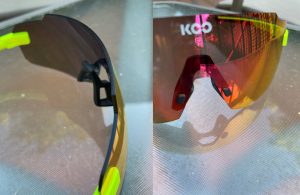 Koo also includes an “Asian nose bridge” that you can put in place of the one that comes already installed.
Koo also includes an “Asian nose bridge” that you can put in place of the one that comes already installed.
While I’m not sure they intended this, if you drop or put these Supernova sunglasses down on the front of the lens (guilty on both counts), the glasses rest on the rubber nose bridge tabs that pop through the lens rather than the lens itself. It’s somewhat similar to the protection that a mobile phone case gives you that just extends a couple of millimeters above the display edge.
Adding to these fit and airflow characteristics, the Supernova also feels very light (22 grams on my scale to be exact) and makes it feel almost like I don’t have any sunglasses on.
Also contributing to that feeling is a lens with great and even clarity. It wraps around my face without letting the sun bypass the lens on the sides, top, or bottom. I tested the Supernova model with a visual light transmission or VLT rating of 20%. Apart from yellow or photochromatic lenses, that rating is one that lets in more light than many full-on sunglasses.
With the mix of sun and shade I ride in here in the Northeast US, that VLT is just right for a sunny or mostly sunny day. The colors are true, and the road surface is clearly defined. If you ride where the sun is stronger and the shade is sparse, lens options with only 12% VLT will filter out more sun.
The Supernova seems to fall somewhere between the modern max coverage lens and the far smaller, classic cycling glasses lens size. For my relatively narrow face, they seem to do the job of completely filtering the sun without me looking like I’m wearing ski goggles.
Being able to pick a mirrored lens and arms from a wide range of colors also allows you to wear glasses that fit your tastes a bit more than some others. These KOO Supernova sunglasses almost make me look like a modern cyclist with some style, younger than my hair color, and slow climbing speeds would otherwise suggest.
Miles’s cycling sunglasses choices
Miles has had a helluva riding year. He’s always been a successful Pro/1/2 rider on the road race and crit circuit in New England and picked up where he left off with racing restarting in 2021. He and his wife also put on an awesome gravel race starting and ending at her family farm in Vermont this summer, and Miles figured out cyclocross this fall, landing on quite a few podiums.
On top of all that, he probably had as much fun coaching one of his son’s MTB team and riding the trails with them on weekends as anything else he did on a bike this year. Needless to say, he’s got a lot of different “use cases” for cycling sunglasses.
Here are his reviews of three cycling sunglasses for different situations.
Oakley Sutro Prizm
Available starting at US$127/£115/€140 using these links to Competitive Cyclist, BTD (BikeTiresDirect), Performance Bicycle, Merlin, Sigma Sports, Amazon, and BikeInn.
I chose the Polished Black/PRIZM Snow Torch version of the Oakley Sutro Prizm cycling sunglasses for my sunny road rides.
These have big coverage and weigh very little, both huge pluses in my book, especially in combination. While I am not generally a huge fan of sunglasses with frames that go all the way around the lens, as I sometimes find the frame can limit visibility, the top bar frame on these Sutro Prizm’s is really out of sight most of the time.
I wore these in direct afternoon sun, and while they are not super dark, I can see really well, even when looking
straight into the sun reflecting off the road or grass.
These glasses are also super comfortable and perch up at just the right distance off my face. The arms are pretty flexible and minimal. I also found that they fit securely into my Kask helmet.
They are very, very cool looking. I could see wearing them as much off the bike as on the bike. The case is a pretty standard one that zips up and comes with a simple black bag. It’s easy to pack and carry around safely.
Overall, these are very nice glasses that make me feel like Egan Bernal (a little)!
Smith Attack MAG MTB ChromaPop
Available starting at US$135/£171/€243 using these links to Competitive Cyclist, Amazon, and BikeInn.
The Smith Attack Mag MTB ChromaPop has a photochromic lens and a light amber one. It is designed for mountain biking and other types of trail riding.
Unlike any cycling glasses I’ve seen before, the narrow upper frame piece is permanently installed on top of the lens. There’s also a wide nose piece that extends halfway across the lower part of the frame. I could see the lower bar on the lens when riding but then I did not notice it after a while. The frame arms also clip off with a really unique mechanism that I loved (no torquing!).
These glasses were great in the woods on long, 50-mile mountain bike rides. The photochromic lens provides the perfect level of shade on a sunny day in the mountains. Of the three I tested, these do the best job for what they are designed for – mountain biking. In other words, these were better for mountain biking than the Sutros were for
sunny road riding.
That exceptional purpose-built performance brings limitations when using them outside mountain bike riding. For example, they don’t go deep enough into the vents of my Kask Protone helmet and obstruct my view if I ride with them there. I would also say the frame and nose piece don’t give you a very stylish look off the bike.
These Smith cycling sunglasses come with a case that’s oversized by about a couple of centimeters. This makes
them a little more clunky to travel with.
And they’re more expensive than most cycling sunglasses. But if you’re looking for a pair ideally suited for mountain biking, the Smith Attack Mag MTB ChromaPop is hard to beat.
* * * * * * *
Thank you for reading. Please let me know what you think of anything I’ve written or ask any questions you might have in the comment section below.
If you’ve benefited from reading this review and want to keep new ones coming, buy your gear and kit after clicking the store links in this review and others across the site. When you do, we may earn an affiliate commission that will help me cover the expenses to create and publish more ad-free, subscription-free, and reader-supported reviews that are independent, comprehensive, and comparative.
If you prefer to buy at other stores, you can still support the site by contributing here or by buying anything through these links to eBay and Amazon.
You can use the popup form or the one at the bottom of the sidebar to get notified when new posts come out. To see what gear and kit we’re testing or have just reviewed, follow us by clicking the icons below.
Thanks, and enjoy your rides safely! Cheers, Steve
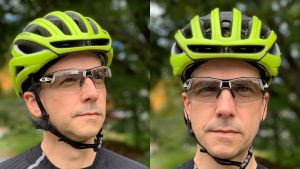

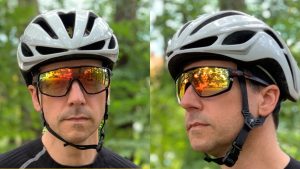

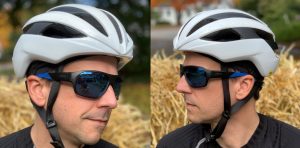
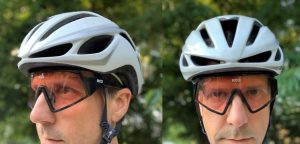









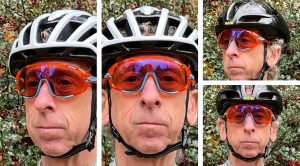

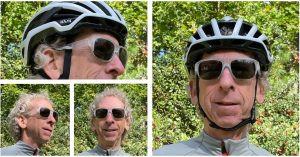

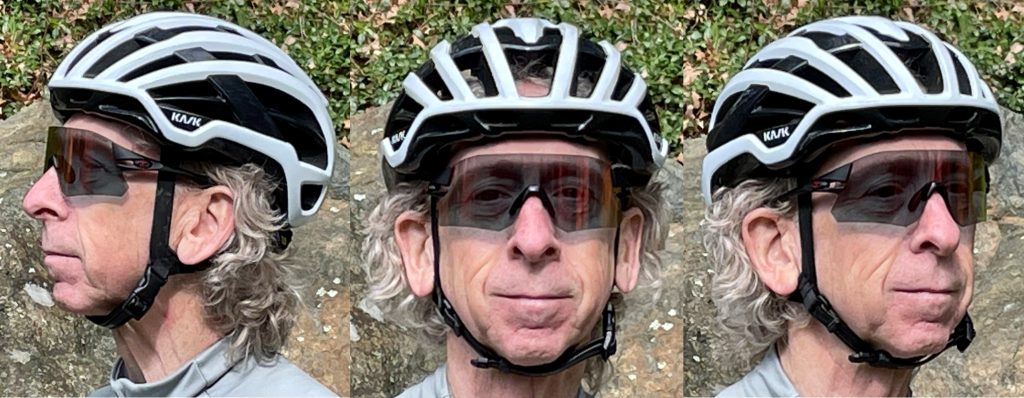

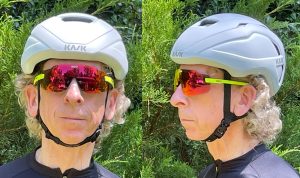

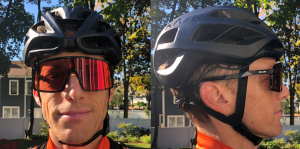



I need vision correction for distance. Many Oakley lenses can be ordered with vision correction. Thru many years & several lense options, Oakley’s deliver startlingly crisp vision; that’s a good thing!!
I’m currently using the Red Road Prism lenses ??. They serve me well in all conditions with one exception, when light is dim in the hour just after sunrise or before sunset, I prefer the Oakely black photochrome lenses that are pretty much clear in low light conditions.
Thx for your informative & friendly reviews Steve & crew!$
Thoughts on the Oakley Katos? Progressive design with excellent lenses.
Just returned a Tifosi rail, they actually distorted my vision slightly. Picked up an Oakley Sutro Photochromic. Big difference for me. Like Assos shorts, some times you get what you pay for!